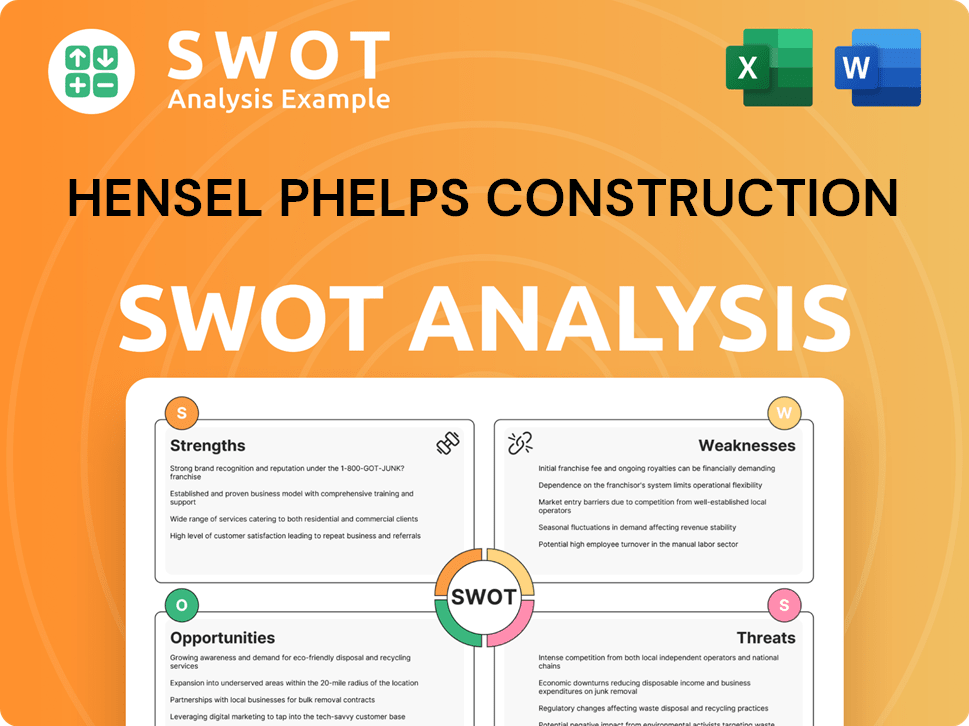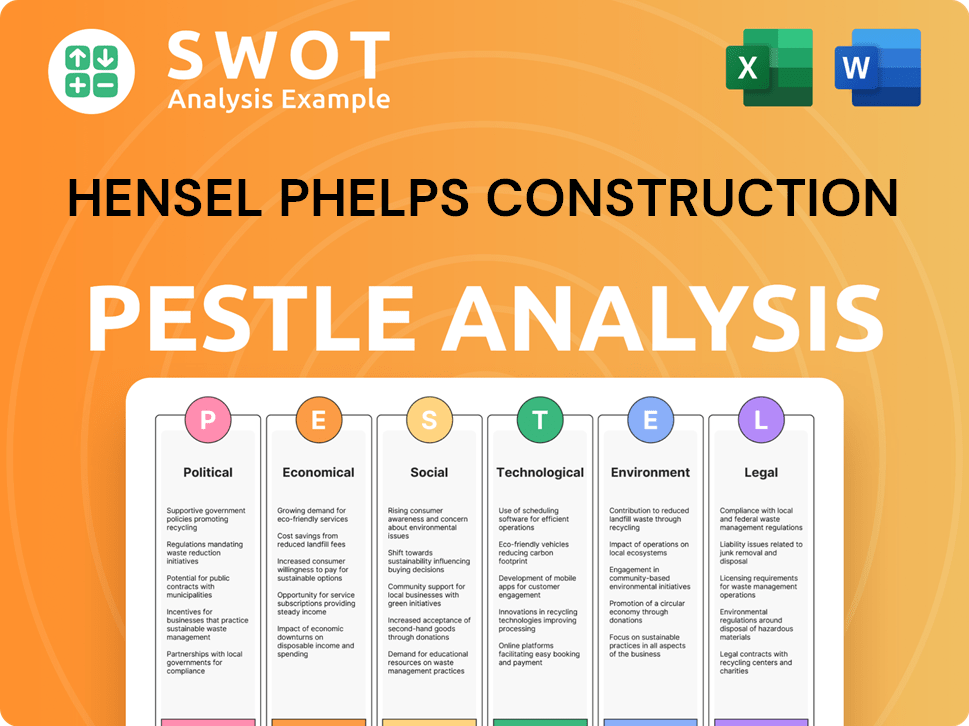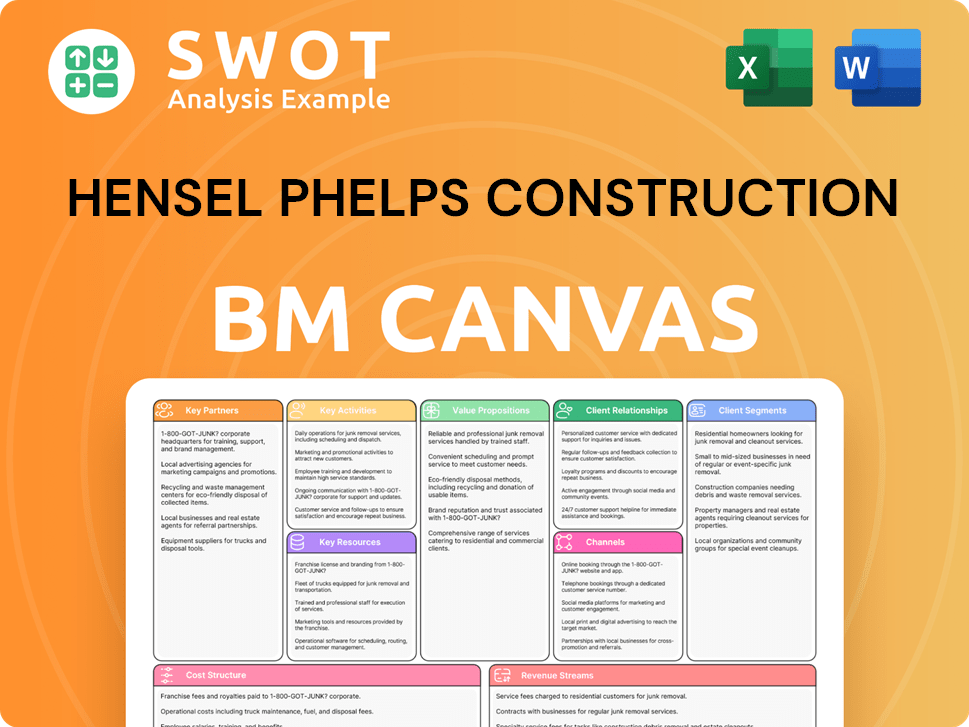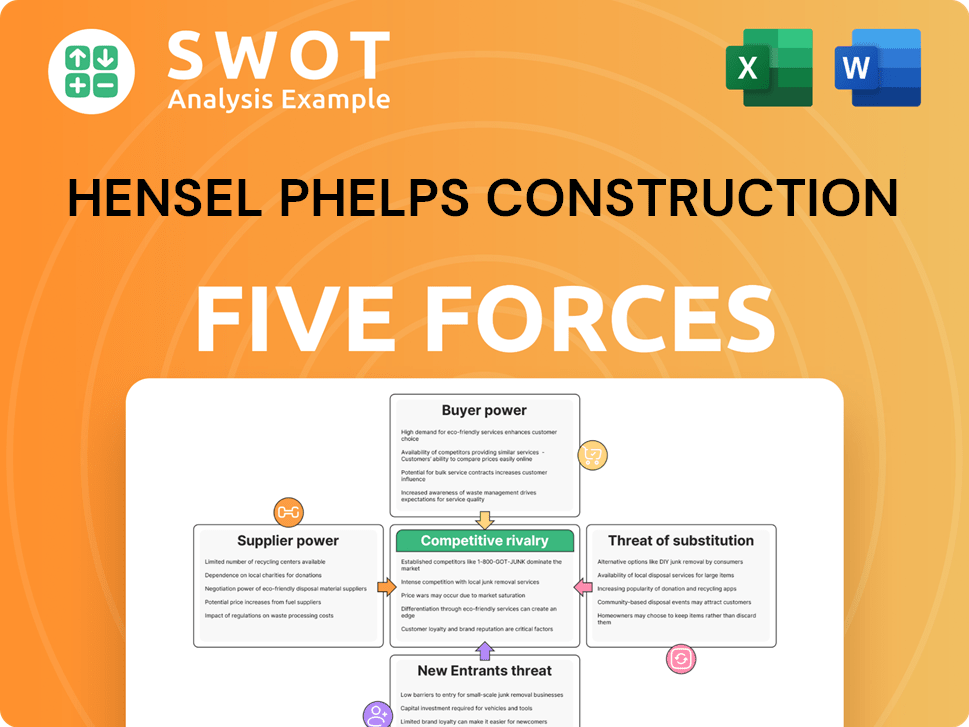Hensel Phelps Construction Bundle
How Does Hensel Phelps Construction Thrive in Today's Market?
Founded in 1937, Hensel Phelps Construction Company has evolved from a regional player into a national construction powerhouse. Its commitment to quality and client satisfaction has fueled decades of growth across diverse sectors. This article dives into the Hensel Phelps Construction SWOT Analysis and the competitive arena where Hensel Phelps strategically operates.

Understanding the Competitive landscape is crucial for any construction company analysis. We'll explore Hensel Phelps Construction's market share, its industry rivals, and its approach to winning construction projects. This includes examining its financial performance, project locations, and how it stacks up against competitors like Turner Construction. Furthermore, we'll investigate Hensel Phelps Construction company's biggest projects and recent acquisitions to understand its growth strategy and market position.
Where Does Hensel Phelps Construction’ Stand in the Current Market?
Hensel Phelps Construction maintains a strong market position within the U.S. construction industry. The company is consistently ranked among the top general contractors, demonstrating its significant scale and influence. Focusing on large-scale, complex projects, the company offers services in preconstruction, construction management, and design-build.
The company's primary product lines span various sectors, including aviation, commercial, healthcare, and government projects. Hensel Phelps has a nationwide presence with offices strategically located across the United States, allowing it to serve a broad customer base. Its customer segments include public and private entities requiring large-scale infrastructure and building projects.
Over time, Hensel Phelps has solidified its position as a leader in complex, high-value projects, often involving stringent safety and security requirements. The company's financial health is strong, supported by its consistent revenue generation and a solid project backlog. The company's ability to deliver projects safely, on time, and within budget strengthens its market position. This positions Hensel Phelps favorably against industry averages, especially in aviation and government sectors.
In 2023, Hensel Phelps was ranked 8th on Engineering News-Record's (ENR) list of the Top 400 Contractors, based on 2022 revenue of $6.2 billion. This ranking highlights its significant market share and influence within the construction industry. The company's consistent presence in the top rankings underscores its financial stability and operational efficiency.
Hensel Phelps focuses on large-scale, complex projects across various sectors. Key sectors include aviation, commercial, healthcare, and government. Recent projects include the Terminal 1 modernization at San Diego International Airport, demonstrating its expertise in aviation projects. This diversification helps mitigate risks and ensures a steady stream of projects.
The company has a nationwide presence with offices strategically located across the United States. This allows Hensel Phelps to serve a broad customer base. Customer segments include public and private entities that require large-scale infrastructure and building projects. This wide geographic reach supports its ability to secure diverse projects.
Hensel Phelps' financial health is strong, supported by consistent revenue generation and a solid project backlog. In 2023, the company reported new contracts totaling $6.2 billion, indicating robust demand for its services. This financial strength supports its ability to invest in future projects and maintain its competitive edge.
Hensel Phelps' strengths include its ability to handle complex projects, its strong financial performance, and its diverse project portfolio. The company's market position is enhanced by its focus on delivering projects safely, on time, and within budget. This positions Hensel Phelps favorably against industry averages.
- Consistently ranked among the top general contractors in the U.S.
- Strong presence in aviation, commercial, healthcare, and government sectors.
- Nationwide presence with strategically located offices.
- Reported new contracts totaling $6.2 billion in 2023.
Hensel Phelps Construction SWOT Analysis
- Complete SWOT Breakdown
- Fully Customizable
- Editable in Excel & Word
- Professional Formatting
- Investor-Ready Format

Who Are the Main Competitors Challenging Hensel Phelps Construction?
The Competitive landscape within the construction industry is dynamic, with numerous firms vying for projects across various sectors. Understanding the key players and their strategies is crucial for assessing Hensel Phelps Construction's market position and potential growth. This analysis provides insights into the major competitors challenging Hensel Phelps Construction.
The construction industry is characterized by intense competition, where factors like project size, geographical location, and specialized expertise determine the competitive dynamics. Construction company analysis requires a deep understanding of each firm's capabilities, financial health, and strategic focus. This chapter examines the key competitors of Hensel Phelps Construction to provide a comprehensive view of the market.
Hensel Phelps Construction faces competition from a variety of construction companies, each with its own strengths and areas of focus. These competitors often compete for similar projects, especially in the commercial, institutional, and infrastructure sectors. The competitive landscape is further shaped by factors such as technological advancements, sustainability practices, and the ability to secure large-scale projects.
Turner Construction, a subsidiary of HOCHTIEF, is a major player in the construction industry. It consistently ranks among the top general builders in the U.S. and globally. Turner often competes with Hensel Phelps Construction for large-scale commercial and institutional projects.
Skanska USA, part of the Swedish multinational construction and development company Skanska AB, is another significant competitor. Skanska is particularly active in the public-private partnership (P3) market. The company also has a strong presence in sectors like healthcare and transportation.
Clark Construction Group, a privately held company, is known for its expertise in complex government, healthcare, and infrastructure projects. Clark frequently competes with Hensel Phelps Construction for federal contracts. Clark Construction Group is a significant competitor in the construction industry.
Whiting-Turner Contracting Co. competes with Hensel Phelps Construction across various sectors, including commercial, healthcare, and technology. Whiting-Turner often leverages its strong regional presence to secure projects. This company is a key player in the construction market.
Other firms, including regional players and those specializing in niche markets, also contribute to the competitive landscape. These companies may focus on specific project types or geographic areas. The construction industry is highly competitive.
Competitors employ various strategies, including aggressive bidding, specialized expertise, and strong client relationships. These strategies help them secure projects and maintain their market share. Understanding these strategies is essential for evaluating the competitive dynamics.
The strategies employed by Hensel Phelps Construction's competitors include aggressive bidding, specialized expertise, and strong client relationships. For example, in the aviation sector, companies compete for large airport expansion projects, with factors like past performance and safety records being critical. The industry also sees new players using advanced construction technologies. Furthermore, mergers and alliances among competitors can shift competitive dynamics. For further insights, you can explore Revenue Streams & Business Model of Hensel Phelps Construction.
Several factors influence the competitive dynamics within the construction industry. These include bidding strategies, specialized expertise, and client relationships. Understanding these factors is crucial for assessing the competitive landscape.
- Bidding Strategies: Competitors often use aggressive bidding to secure projects.
- Specialized Expertise: Firms with expertise in niche markets, such as healthcare or aviation, have a competitive advantage.
- Client Relationships: Strong relationships with clients can lead to repeat business and project wins.
- Technological Advancements: The use of technologies like BIM and modular construction can improve efficiency and reduce costs.
- Sustainability Practices: Companies with strong sustainability practices may be favored in certain projects.
Hensel Phelps Construction PESTLE Analysis
- Covers All 6 PESTLE Categories
- No Research Needed – Save Hours of Work
- Built by Experts, Trusted by Consultants
- Instant Download, Ready to Use
- 100% Editable, Fully Customizable

What Gives Hensel Phelps Construction a Competitive Edge Over Its Rivals?
Understanding the competitive landscape is crucial for assessing the performance of any construction company. This analysis focuses on the competitive advantages of Hensel Phelps Construction, a prominent player in the industry. Analyzing the company's strengths, weaknesses, and strategic positioning provides valuable insights for investors and industry observers alike.
Hensel Phelps Construction's success is rooted in several key competitive advantages. These advantages have enabled the company to secure significant projects and maintain a strong market position. This analysis aims to dissect these advantages, providing a comprehensive view of how Hensel Phelps distinguishes itself from its rivals within the Growth Strategy of Hensel Phelps Construction.
The company's approach to project execution, preconstruction services, and client relationships contributes significantly to its competitive edge. By examining these aspects, we can better understand Hensel Phelps' ability to thrive in the dynamic construction market.
Hensel Phelps' ability to self-perform critical aspects of construction projects, such as concrete, structural steel, and mechanical work, sets it apart. This in-house control enhances quality, ensures schedule certainty, and improves cost efficiency. This contrasts with competitors who rely heavily on subcontractors, potentially leading to delays and increased costs.
Hensel Phelps places a strong emphasis on preconstruction services. This early involvement in project planning allows for value engineering, cost optimization, and risk mitigation. This proactive approach leads to more predictable project outcomes for clients, which is a significant advantage in a competitive market.
The company benefits from a strong brand equity and a reputation for delivering complex projects safely, on time, and within budget. This reputation fosters significant customer loyalty and repeat business. This is particularly valuable in sectors requiring high levels of trust and expertise, such as federal government projects and critical infrastructure.
Hensel Phelps has a talented team of experienced project managers, engineers, and skilled craftworkers. This talent pool enables the company to implement innovative construction techniques and maintain rigorous safety standards. The company's commitment to continuous improvement through training, technology, and process enhancements further strengthens its position.
Hensel Phelps' competitive advantages are multifaceted, encompassing operational excellence, client satisfaction, and strategic investments. These elements collectively contribute to its ability to secure and successfully execute large-scale construction projects. The company's consistent focus on these areas has allowed it to maintain a strong market position.
- Self-Performance: Direct control over critical project elements.
- Preconstruction Services: Early involvement for value engineering and risk mitigation.
- Strong Reputation: Fosters customer loyalty and repeat business.
- Talented Workforce: Drives innovation and maintains high safety standards.
Hensel Phelps Construction Business Model Canvas
- Complete 9-Block Business Model Canvas
- Effortlessly Communicate Your Business Strategy
- Investor-Ready BMC Format
- 100% Editable and Customizable
- Clear and Structured Layout

What Industry Trends Are Reshaping Hensel Phelps Construction’s Competitive Landscape?
The construction industry is currently experiencing significant shifts, creating both challenges and opportunities for companies like Hensel Phelps Construction. These changes are driven by technological advancements, evolving regulations, and changing consumer preferences. Understanding these trends is crucial for navigating the competitive landscape and ensuring future success. A detailed Marketing Strategy of Hensel Phelps Construction can provide additional insights into how the company is positioned to respond to these market dynamics.
The competitive landscape for Hensel Phelps Construction involves assessing industry trends, identifying potential risks, and recognizing opportunities for growth. This analysis includes understanding the impact of technological integration, the importance of sustainable practices, and the need for strategic diversification across core markets. The company’s ability to adapt and capitalize on these factors will determine its market position and future performance.
Technological advancements are transforming project delivery. Building Information Modeling (BIM), AI, and drone technology are becoming standard practices. The construction industry is also seeing increased emphasis on sustainability and green building. Regulatory changes, particularly those related to environmental standards and worker safety, are also driving innovation.
Adapting to new technologies requires continuous workforce training and increased capital investment. A slowdown in government spending on infrastructure or downturns in specific sectors pose risks. Increased competition from global players and specialized firms could intensify pricing pressures. Navigating evolving regulatory landscapes demands greater compliance.
Infrastructure modernization across the U.S. presents a robust pipeline of projects. The demand for sustainable construction offers growth prospects. Strategic partnerships with technology providers can enhance service offerings. Diversification and expansion into new markets are also potential avenues for growth.
The competitive landscape for Hensel Phelps Construction includes understanding market share and industry rivals. Key competitors include Turner Construction, among others. Assessing Hensel Phelps Construction's market position involves analyzing its strengths, weaknesses, and growth strategies. The company's bidding process and project locations also play critical roles.
Hensel Phelps Construction must prioritize technological integration, sustainable practices, and strategic diversification. This involves investing in workforce training, adopting advanced technologies like BIM, and pursuing green building certifications. The company should also consider forming strategic partnerships to expand its service offerings and enhance its competitive edge.
- Technological Integration: Implementing AI for project management and using drones for site monitoring.
- Sustainable Practices: Focusing on green building certifications and energy-efficient designs.
- Strategic Partnerships: Collaborating with technology providers to enhance service offerings.
- Market Diversification: Expanding across core markets to remain resilient and capitalize on opportunities.
Hensel Phelps Construction Porter's Five Forces Analysis
- Covers All 5 Competitive Forces in Detail
- Structured for Consultants, Students, and Founders
- 100% Editable in Microsoft Word & Excel
- Instant Digital Download – Use Immediately
- Compatible with Mac & PC – Fully Unlocked

Related Blogs
- What are Mission Vision & Core Values of Hensel Phelps Construction Company?
- What is Growth Strategy and Future Prospects of Hensel Phelps Construction Company?
- How Does Hensel Phelps Construction Company Work?
- What is Sales and Marketing Strategy of Hensel Phelps Construction Company?
- What is Brief History of Hensel Phelps Construction Company?
- Who Owns Hensel Phelps Construction Company?
- What is Customer Demographics and Target Market of Hensel Phelps Construction Company?
Disclaimer
All information, articles, and product details provided on this website are for general informational and educational purposes only. We do not claim any ownership over, nor do we intend to infringe upon, any trademarks, copyrights, logos, brand names, or other intellectual property mentioned or depicted on this site. Such intellectual property remains the property of its respective owners, and any references here are made solely for identification or informational purposes, without implying any affiliation, endorsement, or partnership.
We make no representations or warranties, express or implied, regarding the accuracy, completeness, or suitability of any content or products presented. Nothing on this website should be construed as legal, tax, investment, financial, medical, or other professional advice. In addition, no part of this site—including articles or product references—constitutes a solicitation, recommendation, endorsement, advertisement, or offer to buy or sell any securities, franchises, or other financial instruments, particularly in jurisdictions where such activity would be unlawful.
All content is of a general nature and may not address the specific circumstances of any individual or entity. It is not a substitute for professional advice or services. Any actions you take based on the information provided here are strictly at your own risk. You accept full responsibility for any decisions or outcomes arising from your use of this website and agree to release us from any liability in connection with your use of, or reliance upon, the content or products found herein.